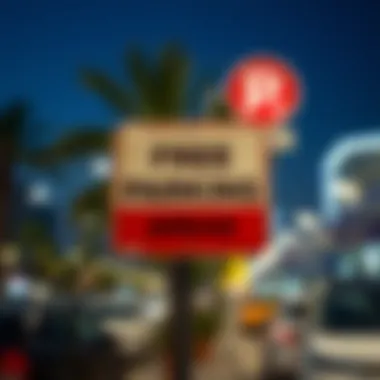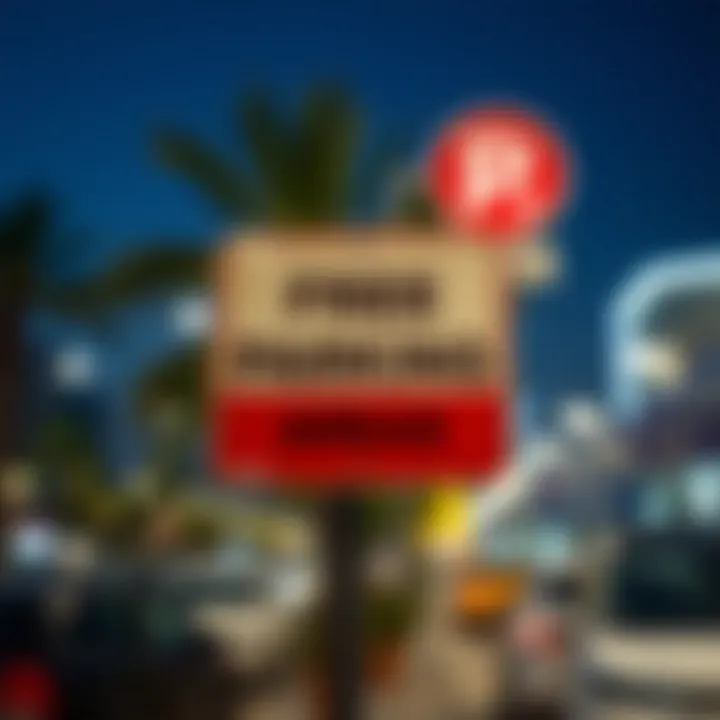Mawaqif Parking in Dubai: Free and Affordable Insights


Intro
In the bustling streets of Dubai, parking can often feel like a maze. Mawaqif parking has emerged as a vital solution tailored to the city's vibrant urban life. This system not merely exists; it shapes the way residents and visitors alike navigate their bustling surroundings. With a variety of options, understanding the nuances of Mawaqif's offerings can be a game changer when trying to park your vehicle effectively—whether that's for a quick errand or a lengthy visit.
But why dig deeper into Mawaqif parking? Well, it’s about saving your time, money, and sometimes sanity. Free and affordable parking is a hot commodity in Dubai, where finding a spot without breaking the bank can feel like searching for gold in a haystack. From the mechanics underpinning Mawaqif parking to wise tips on securing the best deals, each thread we unravel will equip you for a smoother ride through the city.
Mawaqif’s structure is built around promoting efficient parking solutions that align with Dubai's vision for smart city mobility. Understanding this can empower a range of individuals—from daily commuters to curious travelers. The urban landscape here utilizes every square inch in a sense of urgency and modernity, making our exploration of Mawaqif’s offerings crucial. Get ready to unpack the practical advice, insightful details, and the very essence of making your parking experience livable.
So, buckle in as we chart these urban parking waters. With considerate navigation through these aspects, not only will you find a suitable parking spot but also gain valuable insights into this essential facet of Dubai's infrastructure.
Foreword to Mawaqif Parking
Navigating the winding paths of urban parking has become an essential art form, particularly in bustling cities like Dubai. With its rapid growth, the demand for organized parking solutions has never been more pressing. The Mawaqif system stands out as a central feature in the city’s mobility strategy, serving both residents and visitors. Understanding Mawaqif parking is not merely a matter of convenience but also of efficiency and sustainability in urban life.
Overview of the Mawaqif System
Mawaqif launched to tackle the pressing need for structured parking regulation in Dubai. The system has introduced clear delineation of parking zones throughout the city—be it residential areas, commercial malls, or public spaces. Each zone is identified by specific time restrictions and pricing structures, offering clear guidance for users.
Visitors may notice the bright blue signage marking the Mawaqif parking areas, making it easier to locate available spots. This initiative encourages not only better management of parking resources but also aims to enhance the overall urban experience by reducing congestion. The system is quite ingenious, providing flexibility with different payment methods and ensuring that parking spaces are freed up periodically to keep traffic flowing.
Importance of Parking Management in Urban Areas
Urban environments are notoriously challenging when it comes to parking. Without proper management, cities can fall into chaos where drivers endlessly circle, searching for a secluded spot. This practice not only wastes time but also contributes to increased emissions and deteriorating air quality. Proper parking management, like that offered through Mawaqif, ensures that city dwellers and guests have consistent access to spaces without contributing to road congestion.
Mawaqif systems exemplify how strategic planning can transform ordinary environments into orderly experiences. Benefits from this management aren't limited to drivers; local businesses also thrive as customers find it easier to access shops and services. Parking efficiency ultimately bolsters the city’s economy, enhances commuters’ experiences, and fosters a more attractive livability.
"In urban areas, efficient parking management is the cornerstone of a sustainable city infrastructure."
In sum, understanding the Mawaqif system isn’t just about finding a place to park; it encapsulates the broader picture of urban mobility and the ongoing effort to create structured, accessible environments for everyone. As we delve deeper into the nuances of Mawaqif parking, the discussion will reveal essential considerations for users, paving the way toward intelligent and informed parking decisions.
Understanding Free Mawaqif Parking
Comprehending the nuances of free Mawaqif parking is vital for anyone navigating the busy streets of Dubai. With urban mobility being a hot topic in today’s fast-paced world, knowing where to park without shelling out cash can be a real game changer. For residents, tourists, and even business professionals, understanding how to take full advantage of these free parking options not only saves money but can also reduce stress while making trips across the city smoother.
Eligibility Criteria for Free Parking
There are specific criteria that determine who can access free Mawaqif parking. Generally, certain categories of vehicles are eligible, including those belonging to residents with special permits, and vehicles used by individuals with disabilities. If you're a resident, it’s important to ensure your vehicle is registered correctly in the system.
- Residents with permits: Those who live in designated areas can apply for a free parking permit to avoid charges.
- People with disabilities: Vehicles carrying individuals with disabilities can avail of free parking in designated spots.
- Emergency Services: Vehicles for police, fire, or ambulances often get additional considerations or exempt status.
To check if you’re eligible, simply head to the official Mawaqif website or consult the relevant local governmental portals for specific details related to permits.
Duration and Locations of Free Parking
Understanding the duration allowed for free parking is equally significant. Each zone designed for free parking has its stipulations regarding how long you can leave your vehicle without incurring fees. Generally, if you’ve secured a permit, you might be looking at extended parking times, but if you're just weighing your options, you might find that free parking is limited to:
- Up to 2 hours: Typically, visitor spots allow temporary use for free, encouraging quick trips or errands.
- Certain Zones: Areas near shopping centers or community hubs tend to offer more free parking spaces to stimulate local business.
When scouting for free Mawaqif parking, you should keep an eye out for signs that indicate both time limits and the exact zones where free options apply. These details can change frequently, so staying updated through the Mawaqif app or website could prevent unnecessary fines.
How to Access Free Parking Spaces


Finding free parking may feel like searching for a needle in a haystack, but there are methods to simplify this task. Using technology wisely can streamline the process. Here are some tips:
- Download the Mawaqif App: This handy tool provides real-time information about available parking spaces, including which ones are free. The user-friendly layout allows ease in navigation.
- Utilize Online Maps: Services like Google Maps often highlight parking areas. Just make sure to toggle filters to spot free spaces.
- Stay Informed via Local News: Local community boards or websites sometimes announce updates on free parking, especially during events or festivals when demand spikes.
Mawaqif Parking Fees and Charges
Understanding the Mawaqif Parking Fees and Charges is fundamental for anyone navigating Dubai's bustling urban landscape. The parking system has been set in place to not only regulate car spaces but also to foster a smoother flow of both vehicular and pedestrian movement. This section aims to shed light on the various facets of parking fees, making the search for affordable options clearer, especially in a city where real estate prices and living expenses often come with a hefty price tag.
Understanding the Fee Structure
Diving into the fee structure can feel like stepping into a maze, but it’s genuinely more straightforward than it seems. Mawaqif parking spots generally operate on a pay-by-hour basis, and the rates can vary significantly based on location and time. For example, parking in high-traffic areas like Downtown Dubai tends to cost more per hour compared to suburban zones. Here’s how the pricing typically breaks down:
- Premium Locations: Usually around 5 AED per hour.
- Standard Areas: Generally 3 AED per hour.
- Suburban Parking: Most often about 2 AED per hour.
It's crucial to pay attention to parking signage as it indicates specific rates that might change based on peak hours or seasonal demand. Failing to read the fine print can lead to unexpected surprises.
Payment Methods Available
When it comes to payment methods, Mawaqif offers diverse options, making it easier for users to settle the parking fees. Payment can be made through:
- Mawaqif Parking Meters: These machines usually accept both cash and card payments. Just follow the onscreen prompts to complete your transaction with ease.
- Mobile Apps: Utilizing tech-savvy solutions like the Dubai Pay or RTA Dubai app can save time and offer the convenience of cashless payments.
- SMS Payment: If you’re in a jam, sending a text message to a specific number can also grant you access to parking space with a little fee.
In addition to these methods, it’s wise to keep track of your parking duration to avoid overpayments or scrambling to feed the meter at the last minute.
Penalties for Non-compliance with Parking Rules
Now, not adhering to the parking regulations can lead to fines more painful than a stubbed toe. Penalties for non-compliance vary based on the nature of the violation. Some common infractions include:
- Expired Ticket Violation: Leading to a fine of 100 AED.
- Parking in Reserved Spaces: This could lead to even heftier fines, around 500 AED.
- Obstructing Traffic: Can quickly escalate to a violation fee of 250 AED.
To add another layer to this already pressing issue, it is advised to keep a close eye on the Mawaqif parking zones and always double-check your parking receipt. Oftentimes, a slight error can unlock charges that were easily avoidable.
"Fines can accumulate quicker than you blink—be mindful to dodge those unexpected financial landmines!"
In summary, the knowledge of parking fees and charges is as essential as knowing the backroads of Dubai itself. Understanding this can lead to better budgeting for both daily commuters and visitors aiming to explore the city. By utilizing the various payment methods and remaining cognizant of penalties, one can easily maneuver through the intricacies of the Mawaqif parking system.
Tips for Utilizing Mawaqif Parking
When it comes to Mawaqif parking, having a plan is more crucial than ever. With rising numbers of vehicles in Dubai, navigating the parking game can feel like trying to find a needle in a haystack. Skilled strategizing means that visitors and locals alike can enjoy hassle-free parking experiences while saving a few dirhams along the way.
Strategizing Your Parking Choices
Parking in Dubai can be a bit of a puzzle, but understanding your options can make all the difference. Here are some strategies that make parking less of a burden:
- Plan Ahead: Before you even set out, check where you’re heading and see if there's parking available in that area. Websites and apps can provide real-time info on parking availability, helping you to dodge crowded lots like a pro.
- Know the Free Zones: Familiarize yourself with areas where Mawaqif offers free parking. Often, these spots are well-maintained and conveniently located.
- Consider Time of Day: Parking demand shifts throughout the day. If you can, aim to park during off-peak hours. This will often lead to finding a spot without too much fuss.
Using Technology to Simplify Parking
In this digital age, technology has your back, especially when it comes to parking. Here’s how you can harness its power:
- Mobile Applications: Utilizing Mawaqif’s app can be a game-changer. The app allows you to find available spaces nearby, pay for parking, and even top up your balance easily—all in a few taps. Think of it as having a personal parking assistant right in your pocket.
- GPS Navigation: Most smartphone navigation apps like Google Maps offer overlays that display parking availability. This can guide you directly to the nearest available spot instead of driving around in circles.
- Alerts and Notifications: Set up alerts for your parking session. This will remind you when your time is almost up and help avoid those annoying fines.
Best Practices for Parking in Busy Areas


Parking in Dubai's bustling hotspots can be a bit tricky. Here are a few best practices to keep in mind:
- Arrive Early: If you have plans to visit popular attractions or events, arriving early can be key. It provides an edge over the crowd and increases your chances of landing a good spot.
- Be Mindful of Traffic Rules: Stick to posted signs and regulations. Familiarize yourself with local laws concerning parking—disregarding these can lead to hefty fines that could put a damper on your day.
- Always Check Payment Options: Ensure you know how to pay for your parking. Some areas may only accept specific payment methods or have limitations on card types.
"Planning is key in navigating the urban jungle—especially when it comes to parking. A little groundwork can save both time and money."
By applying these strategies and leveraging technology, you can take the stress out of parking in Mawaqif zones. This ultimately leads to a more enjoyable experience exploring Dubai's vibrant streets, allowing you to focus on what really matters: your journey ahead.
The Role of Mawaqif in Urban Development
The Mawaqif parking system is a linchpin in Dubai’s ongoing urban development, transforming the way people navigate through the city. For real estate agents, investors, homebuyers, and renters, understanding the implications of this system is pivotal. It not only affects immediate parking availability but also influences traffic flow, local businesses, and the overall urban landscape.
Impacts on Traffic Management
The introduction of Mawaqif has brought about significant changes in traffic management in Dubai. By regulating parking spaces and encouraging efficient use, it aims to reduce the chaotic congestion that plagued many areas. For instance, implementation of payment structures dissuades prolonged parking in high-demand zones, in turn easing traffic spikes.
Some key points regarding Mawaqif’s impact on traffic management include:
- Reduced Congestion: Fewer vehicles circling to find parking leads to smoother traffic patterns.
- Designated Parking Zones: Clear markers guide drivers to available spaces, minimizing confusion and erratic driving behavior.
- Real-time Information: New technology offers updates on parking availability. This reduces search times and further cuts down traffic.
The synergy created by these changes helps develop a more organized transport system, which is crucial for developers and urban planners in designing future infrastructures.
Benefits to Local Businesses
Local businesses stand to gain immensely from the effective management brought about by Mawaqif. With easier access to parking, more patrons can visit shops and restaurants without the hassle of searching for spots. A thriving local economy relies on steady foot traffic; Mawaqif can help facilitate this through its structured parking approach.
Benefits include:
- Increased Patronage: Easier parking encourages more customers to visit establishments.
- Enhanced Visibility: Clear signage and designated areas increase the profile and appeal of local businesses.
- Community Events: Local events can capitalize on the organized parking systems to draw crowds, fostering community engagement.
For business owners, the implementation of the Mawaqif system is not merely a regulatory measure but a vital support for economic growth.
Enhancing Accessibility in Urban Spaces
Beyond management and business impacts, Mawaqif plays a role in enhancing accessibility across urban spaces. Efficient parking contributes to a more user-friendly city for all, particularly for those who may have mobility constraints. The thoughtfully designed parking spaces are a boon for all sorts of vehicle users, ensuring inclusivity in urban planning.
Some highlights include:
- Designated Accessible Spaces: Special spots available for those with disabilities ensure they have suitable access to buildings.
- Bicycle Parking Facilities: Mawaqif encourages sustainable transport through parking options for bicycles, appealing to eco-conscious users.
- Public Feedback Systems: Ongoing improvements through user feedback channels allow the system to adapt and cater to diverse needs.
Challenges Faced by Mawaqif Parking
Understanding the hurdles that come with Mawaqif parking is crucial for making sense of its overall utility. This section dives into the frequent problems users encounter, the feedback mechanisms in place, and what the future holds for improvements in the system. Each identified challenge provides valuable insight into how to better navigate urban parking in Dubai, which is especially important for property managers, investors, and real estate agents keen on enhancing their clients' experience.
Identifying Common Issues
Mawaqif parking, while beneficial in many respects, does present several challenges that can frustrate users. One of the most pressing common issues is the availability of parking spaces. In areas where demand oversteps supply, finding a spot can feel like searching for a needle in a haystack. Not only can this create delays, but it can also discourage individuals from exploring certain urban areas altogether.
Other identified issues include:
- Confusion Over Parking Zones: With various parking zones having different rules, it can be difficult for users to understand where they can park legally. This lack of clarity can lead to inadvertent violations and fines.
- Time Constraints on Free Parking: Users often report frustration with time limits on free parking services. These short permissible durations sometimes don't align with the needs of busy urban living.
- Insufficient Signage: Many drivers have expressed that the signage related to parking rules and available spaces is either too sparse or poorly placed, leading to further confusion.


These challenges must be addressed head-on to enhance the effectiveness of Mawaqif as an urban parking solution.
User Feedback and Response Mechanisms
Incorporating user feedback is central to improving any system, and Mawaqif is no different. The platform encourages motorists to voice their opinions and experiences, which in turn enables the officials to pinpoint problem areas that need attention. Users can submit grievances online through official channels often hosted on municipal sites. This direct line of communication ensures that voices are heard and solutions are sought.
Highlighting the importance of feedback, municipalities across Dubai often publish reports that summarize trends in user input and outline how they plan to address common concerns. Though the system seems to be intricate, here's what feedback mechanisms typically cover:
- Surveys and Polls: Regularly conducted surveys gauge user satisfaction and gather suggestions for improvement.
- Social Media Engagement: Monitoring platforms like Facebook and Reddit allows for real-time user experiences to be observed and reacted to timely.
- Community Meetings: These gatherings allow users to discuss issues face-to-face with management, leading to immediate attention on pressing matters.
Effective feedback mechanisms not only help in resolving current issues but also in identifying potential areas for future enhancements.
Future Improvements in the System
The trajectory for Mawaqif parking looks promising, with city planners outlining future improvements aimed at addressing existing challenges. Innovations in technology and infrastructure are poised to shape a better parking experience. Some anticipated advancements include:
- Smart Parking Solutions: Integrating technologies such as mobile applications that offer real-time updates on space availability can alleviate the stress of searching for parking.
- Enhanced Signage: Improving digital and traditional signs will ensure clarity in zone regulations and availability, minimizing user confusion.
- Extended Free Parking Options: Re-evaluating the time frames for free parking could attract more visitors to downtown areas, boosting local business and community engagement.
- Community Awareness Programs: Educational initiatives to familiarize users with the Mawaqif system can empower them to use it more effectively.
These improvements will likely result in a more user-centric parking experience, further solidifying Mawaqif's role in enhancing urban mobility in Dubai.
Case Studies of Successful Parking Management
Examining successful case studies of parking management reveals how various systems can enhance urban mobility and align with the pressing demands of city infrastructure. These examples not only provide insight into best practices but also illustrate the transformative effects effective parking solutions can have on urban environments, traffic flow, and local economies. Consequently, by understanding these strategies, Mawaqif can refine its approach to addressing the needs of residents and visitors.
Comparative Analysis with Global Systems
When it comes to parking management, drawing comparisons with global systems offers valuable insights. Different cities tackle the issue of parking in unique ways, driven by local cultures, economic systems, and urban designs.
For instance, look at Singapore's parking system, which implements a robust Electronic Parking System (EPS) to manage demand efficiently. The utilization of real-time data helps control the number of vehicles entering congested zones. Unlike static systems, this dynamic approach allows instant adjustments based on current conditions. Their strategy has notably reduced congestion and maximized space efficiency, which Dubai could explore to improve the Mawaqif system.
Further afield, San Francisco sets a compelling precedent with its SF Park program. This data-driven initiative uses pricing strategies to adjust parking fees based on demand. When you see the advantages of responsive pricing—like reduced congestion and improved availability—it's a model worth considering. These comparisons bring forth essential themes such as scalability, adaptability, and technology integration that Mawaqif could foster.
Lessons Learned from Implementation
Every urban area brings unique challenges, but successful case studies yield universal lessons for Mawaqif. Key takeaways from various implementations include:
- Integration of Technology: Cities that utilized smart technology to gauge real-time parking availability saw positive outcomes. Incorporating mobile apps and sensors can streamline the parking experience, while enhancing user satisfaction.
- User Engagement: Involving the community becomes essential. Feedback loops—like the user surveys conducted in New York City for pay parking systems—help authorities understand the expectations of users and adjust the system accordingly. Engaging users ensures that the system meets real-world demands.
- Flexibility in Pricing: Adjusting pricing in response to demand not only increases revenue but also promotes fair access to parking. Cities successfully implementing this saw reduced complaints and increased revenues over time. This concept of flexible pricing could be instrumental in optimizing Mawaqif’s fee structure.
In summation, these case studies and their underlying principles reveal a pressing need for flexibility, technology, and user-centric policies. By acknowledging and adapting these lessons, Mawaqif has the potential to evolve, enhancing urban mobility while also contributing positively to the local economy.
Closure
In wrapping up the topic of Mawaqif parking, it's clear that understanding how this system functions is crucial for both everyday drivers and occasional visitors in Dubai. By covering free and affordable parking choices, users can navigate the bustling streets with ease, spend less time searching for parking, and focus on what really matters—enjoying their time in the city.
Summarizing Key Points on Mawaqif Parking
Essentially, the Mawaqif parking system serves as more than just a place to leave your vehicle. It embodies the broader efforts of urban planning in Dubai aimed at improving accessibility and reducing congestion. Key points include:
- Accessibility: Free parking options offer significant relief to those who may not want to pay daily rates, enhancing access to shopping, dining, and tourism.
- Ease of Use: With a variety of payment methods and mobile applications available, navigating this system has become increasingly user-friendly, making it simpler for motorists to comply with regulations.
- Impact on Urban Life: By managing where and when cars can park, Mawaqif plays a vital role in reducing traffic jams, ultimately improving air quality and urban vibrancy.
These elements are essential to appreciate how the parking system influences daily life in the region.
Looking Ahead to Future Developments
The future of Mawaqif and parking solutions in general appears promising. Innovations in technology are poised to further enhance the user experience. Possible developments may include:
- Smart Parking Solutions: The integration of AI and sensors can create a dynamic parking environment that updates availability in real-time.
- Further Incentives for Eco-friendly Vehicles: As sustainability gains momentum, discounts or dedicated spots for electric and hybrid vehicles could emerge, encouraging more eco-conscious choices.
- Expanded Free Parking Zones: As demand rises, authorities may look to expand the areas that offer free parking, catering to different demographics and enhancing local business traffic.
The possibilities signal a positive shift and can greatly influence how parking aligns with urban expansion.







